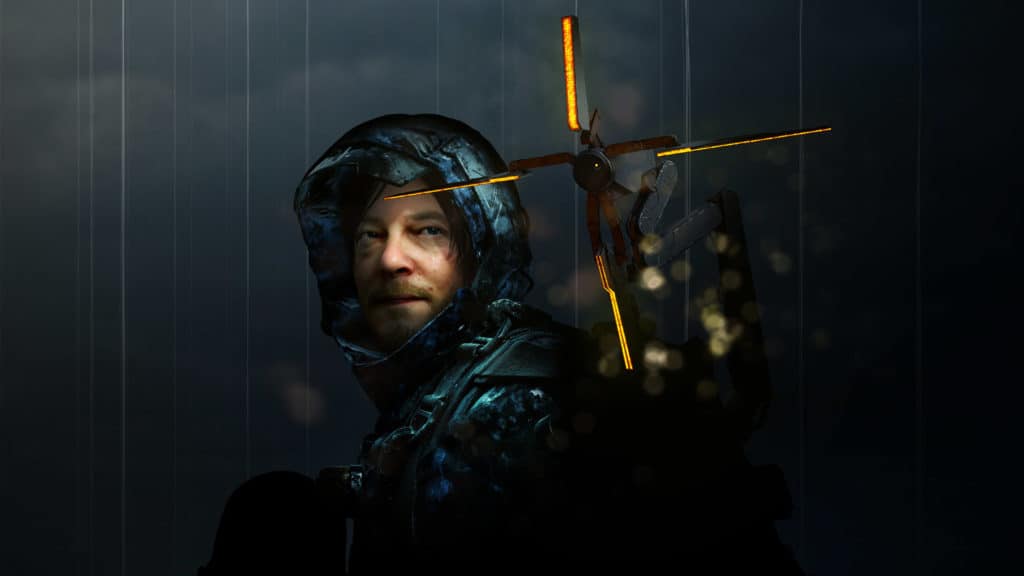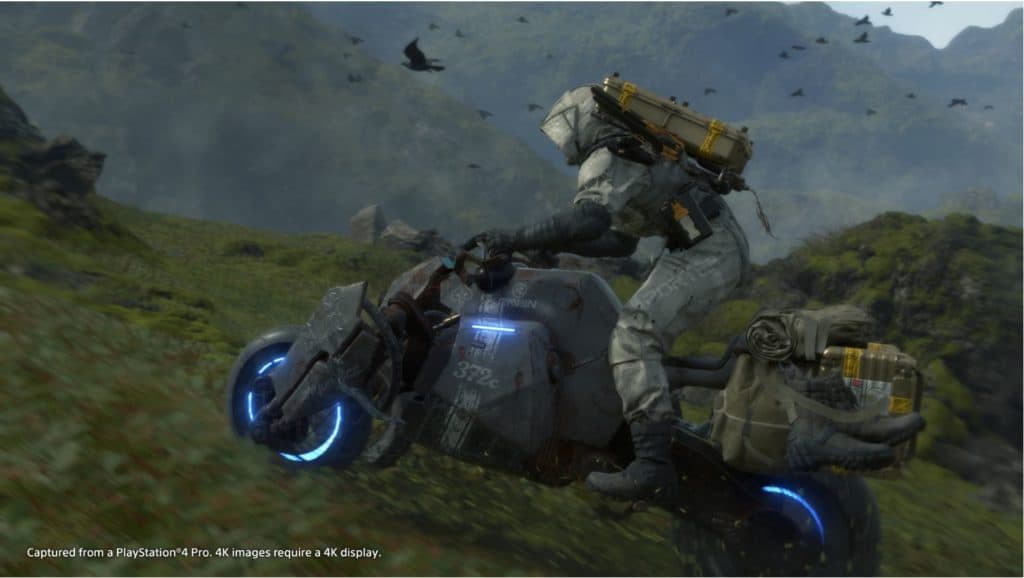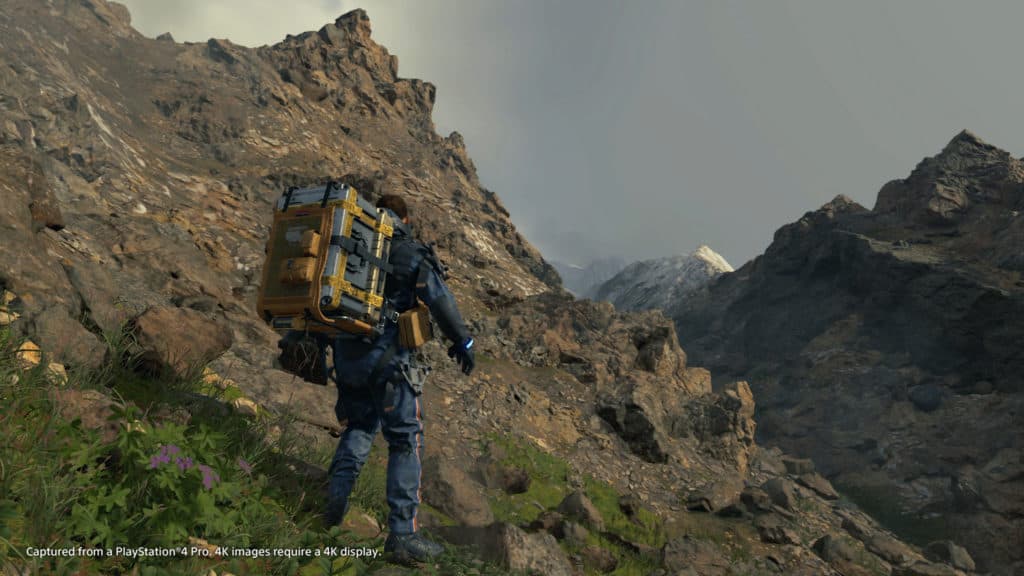A DeconRecon Special Feature
Death
Unstranding
Editor’s note: Games are strange things. It’s a journey unlike movies or books or songs; each player’s experience is as integral to the story as the narrative. And sometimes, we encounter a game that is stranger than usual. Death Stranding is one such game. Creator Hideo Kojima has made yet another masterpiece that defies classification and easy interpretation, one that requires its players to strap on mundanity to take on a journey like no other. Some gamers hate it, while many find themselves unable to pull away.
In the spirit of Kojima, DeconRecon is trying something different too. We present a multi-part series that we’re calling ‘Death Unstranding’, which will be published weekly-ish. It is part analysis, part retrospection, part review, part travelogue, and part slow burning mind trip that possibly no ‘Let’s Play’ video can provide. Our writer, C Nge, takes time between playing to put her experience into words, mostly without knowing what will happen next. And you, dear readers, are essentially her travel buddies. Suffice to say there will be major spoilers, but we will indicate how far along she is in the game.
Ready? Here’s Entry One – think of it as a prologue to the series in which C Nge explores the blurring of lines between Death Stranding and real life.
Zen and the art of being stranded in the Kojima-verse
By: C Nge
Game chapters completed: 2
It’s not an exaggeration to say I have been waiting my entire gaming life for Death Stranding.
Having only joined the global tribe of gamers a mere six years ago while I was already in my 40s, I used to lament how so few games out there are truly immersive and genuinely meaningful for players who find zero appeal in shooting, killing, and escaping into pure fantasy. I have no problems with grinding and doing repetitive tasks—heck, I have a real-world job so mundanity is my life—but I have always yearned for a game that finds poetry in the prosaic without forsaking the sublime.
Who would have guessed that it would take a 56-year-old Japanese man to fulfill that desire in spades?

Hideo Kojima’s Death Stranding (DS) is a game that resists easy classification. On the surface, it has the look, feel, and user interface of a sci-fi world, but burrow deeper and you will find that DS also explores age-old human preoccupations such as death, loss, and the afterlife, in profoundly philosophical ways.
Twenty hours into DS, my mind is reeling from an inexplicable sense of transcendence—it is as if my AFK world has faded away and my every waking and dreaming moment is now lived in a beguiling alternate universe that looks and feels eerily familiar, yet is discomfitingly not.
Hideo Kojima’s Death Stranding is a game that resists easy classification. Share on XFor Yugoslavian science fiction scholar Darko Suvin, this alternate universe is a place of ‘cognitive estrangement’—his definition of science fiction—because our brains register a sense of disconnect with this new world, even as we happily inhabit its spaces. Since DS is set in a post-apocalyptic, futuristic world and tackles a slew of uncannily prescient sci-fi themes, Suvin’s description is very fitting.
spoilers ahead
Death Stranding begins with what Kojima fans have come to expect from their deity: a somewhat long (by game standards, not Kojima standard) and incredibly cinematic cutscene.
A black screen and a lone male voice greets us:
“Once, there was an explosion. A bang which gave birth to time and space.
Once, there was an explosion. A bang which set a planet spinning in that space.
Once, there was an explosion. A bang which gave rise to life as we know it.
And then came the next explosion.”
This inaugural text surprised me because I did not expect such hubris in verse. The four lines uttered in inky darkness resonated with such compact biblical, scientific, and gaming portent, I had goosebumps. Like the archetypal ‘once upon a time’, these lines cleverly evoke the Big Bang theory of creation, while weaving into it a different catalyst for a new narrative: “the next explosion” of Kojima’s design.
It is as if Kojima then declares, ‘let there be light and let there be a haunting soundtrack to accompany that light’ because amazing vistas, evocative of Ridley Scott’s Prometheus (2012), are gradually revealed to us against the aural backdrop of Low Roar’s moody and atmospheric, Iceland-inspired ‘Don’t Be So Serious’, a song title that cheekily reminds us we are still only playing a game, folks.
But this is surely no ordinary game because the DS world comes into being in almost biblical form. I found myself back in primary school catechism class, reciting the initial verses from Genesis but with a twist: first, there was darkness and we could only grasp at words. Then darkness gave way to light and we saw the creation of heaven and earth, water and land, rocks and trees—six frames in all for this first scene, just as the Judeo-Christian God made the world in six days.
DS is a world of greys, muted hues, and a misty drizzle, empty of humans but full of desolation. Its topography looks remarkably familiar but if you are observant, your eyes will detect at least one element in each frame that is odd, mystifying, and unworldly—inverted rainbows, floating rocks, etc. Cognitive estrangement never felt more palpable.
By this point, less than 30 seconds in, I am well and truly hooked.
As the title credits roll and ever more beautiful landscapes unfold, I luxuriate in how seamlessly the complementary visual media of games and films have converged. Kojima is an admitted cinephile, watching a film a day since he was a child, and his evident love affair with films is resplendent in DS.
The game’s opening aerial tracking shot of a motorcyclist raising dust, as man and machine snake their way against an unforgiving landscape—a speck in the distance at first, then slowly coming into close-up view—is subtly reminiscent of one of my favourite opening scenes in cinema: Stanley Kubrick’s The Shining (1980).
Nonetheless, I know I am in Kojima-verse when Walking Dead TV series icon Norman Reedus’ unmistakable mug fills my screen. He sports a pair of sunglasses that resembles a streamlined HoloLens and is decked out in a futuristic-looking, armoured body suit. He then proceeds to careen around on his motorbike, and as the raindrops fall, he skids on gnarly terrain and leaps over a gorge.

Reedus is the protagonist, Sam Porter Bridges, and the player’s surrogate. At this point, my thumbs are itching to take charge of his uber cool bike filled with cases of cargo and speed my way through this incredibly designed environment, but Kojima does not allow me to hold the reins just yet.
Without warning, a woman (Lea Seydoux) holding an umbrella materialises—seemingly out of nowhere—and I watch aghast as Sam barrels into her with his bike, falls off of it, and loudly curses as his vehicle plummets off a cliff. The woman vanishes, the skies break and a steady rain begins to fall. The next thing I know, the cutscene ends and a UI pops up, indicating I need to retrieve my lost cargo.
“WTF!” is all I kept thinking. Is this game going to make me climb down that cliff to retrieve my bike? Do I have to locate parts to rebuild it?
Nope. What Kojima did instead was make me pay for every dollar I spent on his game by forcing me to occasionally run, but mostly walk, hike, climb, and very often trudge, lumber, stagger, stumble, traipse, lurch, and flounder. I never knew so many expressions existed to precisely describe the intricacies of such a simple movement as putting one foot in front of another. I also never knew walking would place such high demands on my power of concentration and doggedness.
I would later joke on social media that DS is basically a high level walking simulator, albeit designed by a genius. Serendipitously, I happen to love games that have walking as their core mechanic; some of my favourite indie games—Year Walk, Beyond Eyes, Emporium, and Kentucky Route Zero—are essentially walking simulators overlaid with a thin veneer of puzzle-solving. I guess you could say I was primed to enjoy DS.
In truth, I love solo walking in real life so my gravitation towards walking simulators satisfies a genuine physical need, which the city that I live in is unable to meet. Kuala Lumpur’s lack of proper sidewalks and shade from tropical heat, and the insecurity I feel as a female in lonely areas, discourage me from power walking through my home city. When I used to live in the US and Australia, I was ambulatory at least two to three hours a day. During winters, I walked longer and faster because the cold was both invigorating and bracing; four to five hours of daily walking afforded my mind a curiously addictive mental acuity. Walking was my drug when I was abroad. At home, I mostly walk in-game.
Friends who have completed DS tell me the gameplay gets more complex and varied as the story develops but as I’m still stuck in early Chapter 3, all I do is trek around, pick up stuff, take and deliver orders, load my cargo, arrange my pack, plot my route, and fabricate items or tools with which to successfully complete my mission. After all, I play Sam Porter and Sam’s primary task is to deliver cargo, hence his apropos moniker.

I am one of those nuts who find Zen in tedium, so loading and reloading my cargo, arranging and rearranging all the items I carry, and checking and re-checking the map become weirdly meditative. To make things worse, the game UI is so impossibly busy to scan through and navigate that I often find myself stuck at the planning screen, scrolling through endless lists and clicking on countless icons just so I have a handle on what’s going on and what I’ll be doing next.
At heart I am a meticulous planner who’d rather spend 20 minutes organising my load and designing the least dangerous route, than hit the road and die along the way. I hate to respawn, even though I did purposely die one time just to see what my death animation would look like (more about dying and game mechanics in future reviews).
All the same, I wouldn’t have it any other way because DS amply rewards you for your planning, patience and perseverance. You level up based on the condition of your cargo upon successful delivery; you also score more likes and obtain more connection stars (more about this in future entries when I delve into the game story and level design) if you chart new and longer routes.
You do encounter human enemies (MULEs) along the way and you can fight them with your bare fists but your cargo will never escape unharmed. So, if you are like me and take pride in 0% cargo damage, you take the long way around to avoid skirmishes. As a nod to his love for the stealth mechanic, Kojima also gives you the option to play hide and seek with your foes, effectively erasing any need for physical conflict.

By enabling the player to avoid combat with others, ultimately your only combatant is yourself: how far you are willing to trek, how much risk you are willing to take with your cargo, and how much failure you are willing to endure. If you fail a compulsory mission due to damaged or dropped cargo, you have no choice but to restart the mission; so if you walked 3 kilometers before, you’d have to walk 3 kilometers again.
Unwittingly, I am learning a lot about myself while playing DS. Since I have no opponent or competitor in-game, and only have my own mission stats to compete with, I find myself less motivated by a desire to win. Sure, it’s nice to see my stats go up and my stars increase—years of chasing gold stars in school for good behaviour have certainly been imprinted in my psyche—but this is not what induces me to play on.
By enabling the player to avoid combat with others, ultimately your only combatant is yourself: how far you are willing to trek, how much risk you are willing to take with your cargo, and how much failure you are willing to endure. Share on XMuch of Kojima’s brilliance in DS lies in his ability to craft a game story so compellingly enigmatic and outlandish that I play through because I want so desperately to know what happens next. DS is my One Thousand and One Nights and Kojima-san is my Scheherazade.
But it’s not just my nights that Kojima steals; the meditative quality of DS‘ gameplay also robs me of my ability to stay focused at work during the day. When I walk up and down the stairs to and from my 9th-storey office, I imagine climbing over rocks and descending crags. When I load my backpack and plan what to bring to class (Sam ports for a living, I teach), I picture the item checklist UI in DS and I rearrange my pack so I have optimum balance when I stride to class.
Since I started the game, on my drives to and from work I have been looping the songs I’ve unlocked—and stubbornly refuse to play any song that I have yet to hear in-game because I want my sound immersion to match my game progression—and the cars that used to pockmark my journeys now resemble lost cargo I’ve intentionally left behind.
If games are unlike any other media because of their distinctive immersive qualities, then DS should be the immersion gold standard for grown-ups.
Kojima’s creation has achieved something that no other game has yet done for me: it has enabled me to transcend my gamer existence by infusing my real life with new layers of experience and meaning. I am often barrelling through life, checking off to-do lists and striving for maximum work efficiency, but these days I find myself in a fog of pensiveness, slower to react, more taciturn, and Zen.
Perhaps that’s the best state to be in, when you have no idea what lies ahead.
____
End of Entry One. Read Entry Two here.
Follow our Facebook, Twitter, or Instagram to stay updated with our latest posts
Share this? Go ahead, make someone’s day
Also published on Medium.